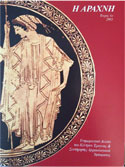April's word: krokos

Crocus, also known as saffron, is a plant producing one of the most expensive spices in the world since ancient times and until today. Saffron comes from the stigmas of the plant with the scientific name Crocus sativus longiflorus, an autumn-blooming species.
The term saffron derives from French safran, from Medieval Lat. safranum, from Arab za'farān, the latter from Persian zarparan, “flower with golden petals”.
There has been a discussion about the Greek term being a loan, see Akkadian kurkanu, Hebrew karkom and Sanscrit kunkuma (probably also a loan). Yet, according to Masson O. 1967 Emprunts semitiques, these also may be loans, perhaps from the Minoan language.
However, the hypothesis of origin in Western or Central Asia has now been denied by botanic research (Mathew B. 1977, “Crocus sativus and its allies (Iridaceae)”, Plant Systematics and Evolution 128).
Indeed, many modern researchers clay that the cultivation of saffron started in Greece, since its use existed already in Minoan Crete and Classical Greece, both as aromatic substance (Homer) and as dyestaff. It derives from Bronze Age Greece (Benda-Weber Ι. 2014 "Krokotos and crocota vestis", in Purpurae VestesIV, 129-142; Grilli Caiola Μ. and Canini Α.,"Looking for Saffron’s Parents", Functional Plant Science and Biotechnology 4) and from there it spread to the Middle East. [See also McGee H. 2004 On Food and Cooking: The Science and Lore of the Kitchen, Scribner; Guillaume J. 2010 Ils ont domestiqué plantes et animaux: Prélude à la civilisation. Éditions Quæ].
The 35 centuries old wall-paintings from Akrotiri, Thera, now at the National Archaeological Museum in Athens, depicting crocus-gatherers are world-known. Thousands of stigmas of the crocus plant had to be collected in antiquity in order for a small amount of dyestuff for textile dyeing to be produced (150.000-160.000 for 1kg of dyestuff! Supra Benda-Weber 2014, 130). Ancient Greeks also knew about the medicinal and therapeutic properties of saffron and they used it as ananesthetic, and to fight insomnia and the unpleasant effects of drunkenness. Moreover, saffron was used in baking, pastry making and cooking, like it is today.
There are several ancient Greek expressions, derivatives and composita based on this term, most of them referring to saffron-dyed textiles (κροκόβαφος, κροκοβαφής (dyed with saffron), κρόκεος, κροκόεις, κροκώδης, κροκωτίδια, κροκωτός (saffron-coloured textiles and garments), κροκωτοφορῶν (person wearing a saffron-coloured garment), κροκόπεπλος (saffron-coloured peplos)…). See Jason’s κρόκεον εἷμα (saffron-coloured garment), Pindar Pyth. 4.232 and Heracles’ κροκωτὸν σπάργανον (saffron-coloured swaddling cloth), Pindar Nem. 1.38. The peplos can be κροκόεις (saffron-coloured), πέπλον […] πυσχ [ / καὶ κλε[. .]σαω / κροκόεντα[ / πέπλον πορφυ[ρ…, Sappho 5.95 D. It is also used metaphorically in poetry, see κροκόπεπλος (wearing a saffron-dyed peplos) for the dawn (Ἠὼς μὲν κροκόπεπλος…).
During the Arkteia Festival in honour of Artemis in Brauron, (Ἄρκτος ἐν Bραυρωνίοις), little girls dancing wore the κροκωτόν (Aristophanes Lys. 645; Souda s.v. Ἄρκτος). Older women, κροκωτὸν ἠμφιεσμέναι (wearing the saffron-coloured garment), dedicated to the goddess, among others, spinning and weaving tools, as well as saffron-coloured garments (IG Ι2 386.22; IG ΙΙ2 1514.60, 62).
Similarly, in some Dionysian ceremonies, women wore a saffron-coloured dress, ἔφεραν κροκωτόν (Pollux 7.94.16-18: αἱ δὲ Βαυκίδες πολυτελὲς ἦν ὑπόδημα, κροκοειδές), while sometimes they also made libations with saffron dye: κρόκου βαφὰς δ’ ἐς πέδον χέουσα, Aeschylus Ag. 239.
The well-known peplos that was offered every year to Athena during the Small Panathenean Festival in order to dress the old statue of the goddess, was also saffron-coloured. The one offered every four years in the Great Panathenean Festival had also the same colour and the shape of the sail on a trireme with wheels. In both cases, the peplos was decorated with Gigantomachy scenes in purple shades, which would stand out beautifully on the saffron-coloured background of the fabric (Euripides Hec. 465-474, Scholia Eur. Hec. 468.7; Stamatopoulou Z. 2012 Weaving Titans for Athena: Euripides and the Panathenaic Peplos (Hec. 466-474 and IT 218-24), Classical Quarterly62.1, 72-80 with references).
Finaly, the term κρόκον refers to the egg yolk, like in Modern Greek (κροκός, and κορκός in Crete).


